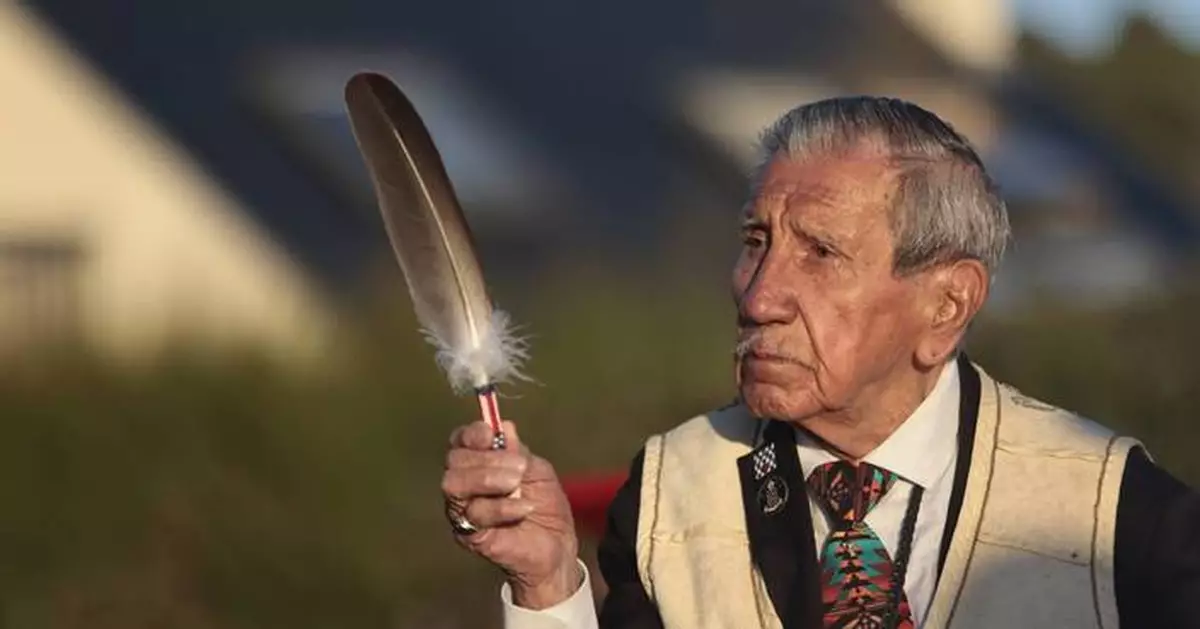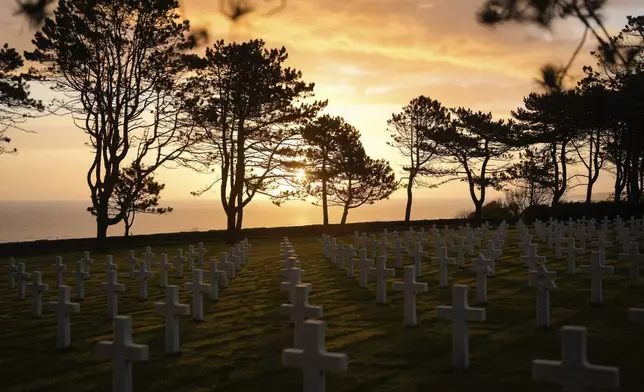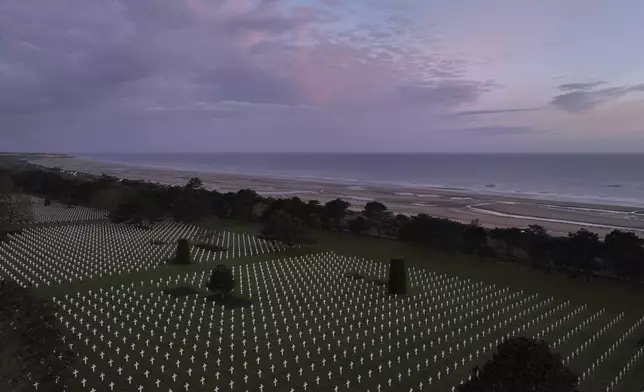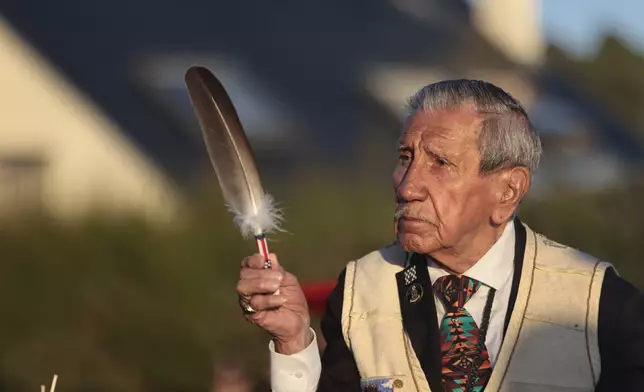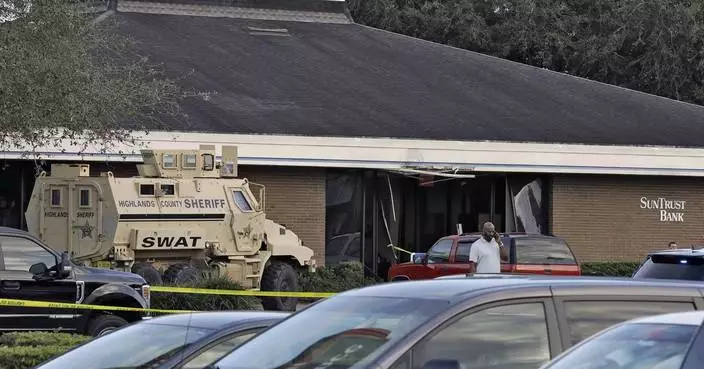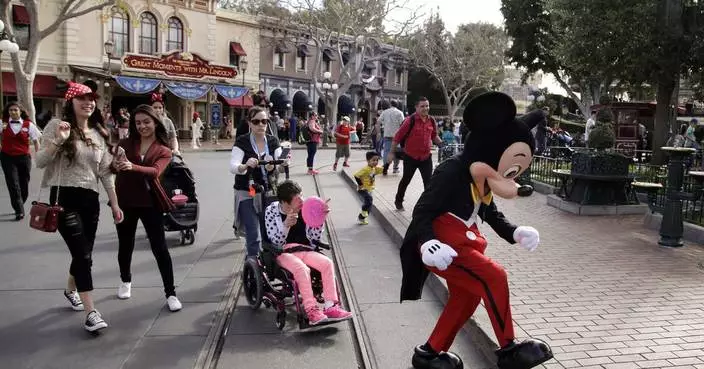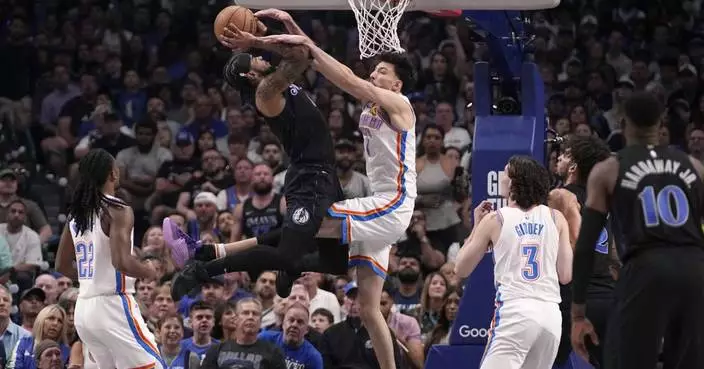BRETTEVILLE-L'ORGUEILLEUSE, France (AP) — On D-Day, Charles Shay was a 19-year-old U.S. Army medic who was ready to give his life — and save as many as he could.
Now 99, he’s spreading a message of peace with tireless dedication as he’s about to take part in the 80th anniversary commemorations of the landings in Normandy that led to the liberation of France and Europe from Nazi Germany occupation.
Click to Gallery
FILE - WWII veteran Charles Shay, 97, right, and Gulf war veteran Julia Kelly pay tribute to soldiers during a D-Day commemoration ceremony of the 78th anniversary for those who helped end World War II, in Saint-Laurent-sur-Mer, Normandy, France, Monday, June 6, 2022. On D-Day, Charles Shay was a 19-year-old Native American army medic who was ready to give his life — and actually saved many. Now 99, he's spreading a message of peace with tireless dedication as he's about to take part in the 80th celebrations of the landings in Normandy that led to the liberation of France and Europe from Nazi Germany occupation.(AP Photo/ Jeremias Gonzalez, File)
FILE — WWII veteran Charles Shay, pays tribute to soldiers during a D-Day commemoration ceremony of the 78th anniversary for those who helped end World War II, in Saint-Laurent-sur-Mer, Normandy, France, Monday, June 6, 2022. On D-Day, Charles Shay was a 19-year-old Native American army medic who was ready to give his life — and actually saved many. Now 99, he's spreading a message of peace with tireless dedication as he's about to take part in the 80th celebrations of the landings in Normandy that led to the liberation of France and Europe from Nazi Germany occupation. (AP Photo/ Jeremias Gonzalez, File)
BRETTEVILLE-L'ORGUEILLEUSE, France (AP) — On D-Day, Charles Shay was a 19-year-old U.S. Army medic who was ready to give his life — and save as many as he could.
The monument called Les Braves, dedicated to the American soldiers who landed on Omaha Beach on D-Day, is seen on Omaha Beach at sunset, in Saint-Laurent-sur-Mer, Normandy, Thursday, April 11, 2024. On D-Day, Charles Shay was a 19-year-old Native American army medic who was ready to give his life — and actually saved many. Now 99, he's spreading a message of peace with tireless dedication as he's about to take part in the 80th celebrations of the landings in Normandy that led to the liberation of France and Europe from Nazi Germany occupation. (AP Photo/Thibault Camus)
Students walk by a bunker in Longues-sur-Mer, Normandy, Thursday, April 11, 2024. On D-Day, Charles Shay was a 19-year-old Native American army medic who was ready to give his life — and actually saved many. Now 99, he's spreading a message of peace with tireless dedication as he's about to take part in the 80th celebrations of the landings in Normandy that led to the liberation of France and Europe from Nazi Germany occupation. (AP Photo/Thibault Camus)
This photo taken on Wednesday April 10, 2024, shows crosses of the US cemetery of Colleville-sur-Mer, Normandy. On D-Day, Charles Shay was a 19-year-old Native American army medic who was ready to give his life — and actually saved many. Now 99, he's spreading a message of peace with tireless dedication as he's about to take part in the 80th celebrations of the landings in Normandy that led to the liberation of France and Europe from Nazi Germany occupation. (AP Photo/Thibault Camus)
The sun rises on the US cemetery of Colleville-sur-Mer, Normandy, Wednesday, April 10, 2024. On D-Day, Charles Shay was a 19-year-old Native American army medic who was ready to give his life — and actually saved many. Now 99, he's spreading a message of peace with tireless dedication as he's about to take part in the 80th celebrations of the landings in Normandy that led to the liberation of France and Europe from Nazi Germany occupation. (AP Photo/Thibault Camus)
The sun rises on Omaha Beach in Colleville-sur-Mer, Normandy, Wednesday, April 10, 2024. On D-Day, Charles Shay was a 19-year-old Native American army medic who was ready to give his life — and actually saved many. Now 99, he's spreading a message of peace with tireless dedication as he's about to take part in the 80th celebrations of the landings in Normandy that led to the liberation of France and Europe from Nazi Germany occupation. (AP Photo/Thibault Camus)
This photo taken on Wednesday April 10, 2024, shows crosses of the US cemetery of Colleville-sur-Mer, Normandy. On D-Day, Charles Shay was a 19-year-old Native American army medic who was ready to give his life — and actually saved many. Now 99, he's spreading a message of peace with tireless dedication as he's about to take part in the 80th celebrations of the landings in Normandy that led to the liberation of France and Europe from Nazi Germany occupation. (AP Photo/Thibault Camus)
This photo taken on Wednesday April 10, 2024, shows crosses of the US cemetery of Colleville-sur-Mer, Normandy. On D-Day, Charles Shay was a 19-year-old Native American army medic who was ready to give his life — and actually saved many. Now 99, he's spreading a message of peace with tireless dedication as he's about to take part in the 80th celebrations of the landings in Normandy that led to the liberation of France and Europe from Nazi Germany occupation. (AP Photo/Thibault Camus)
A man walks on Gold beach in Arromanches, Normandy, Wednesday, April 10, 2024. In the background are the remains of the artificial harbor of Arromanches. On D-Day, Charles Shay was a 19-year-old Native American army medic who was ready to give his life — and actually saved many. Now 99, he's spreading a message of peace with tireless dedication as he's about to take part in the 80th celebrations of the landings in Normandy that led to the liberation of France and Europe from Nazi Germany occupation. (AP Photo/Thibault Camus)
A girl watches the monument called Signal, dedicated to the American soldiers who landed on Omaha Beach on D-Day, on Omaha Beach at sunset, in Saint-Laurent-sur-Mer, Normandy, Tuesday, April 9, 2024. On D-Day, Charles Shay was a 19-year-old Native American army medic who was ready to give his life — and actually saved many. Now 99, he's spreading a message of peace with tireless dedication as he's about to take part in the 80th celebrations of the landings in Normandy that led to the liberation of France and Europe from Nazi Germany occupation. (AP Photo/Thibault Camus)
People walk on Omaha beach at sunset, in Saint-Laurent-sur-Mer, Normandy, Tuesday, April 9, 2024. On D-Day, Charles Shay was a 19-year-old Native American army medic who was ready to give his life — and actually saved many. Now 99, he's spreading a message of peace with tireless dedication as he's about to take part in the 80th celebrations of the landings in Normandy that led to the liberation of France and Europe from Nazi Germany occupation. (AP Photo/Thibault Camus)
Men of the American assault troops of the 16th Infantry Regiment, injured while storming a coastal area code-named Omaha Beach during the Allied invasion of the Normandy, wait by the chalk cliffs at Collville-sur-Mer for evacuation to a field hospital for further treatment, June 6, 1944. On D-Day, Charles Shay was a 19-year-old Native American army medic who was ready to give his life — and actually saved many. Now 99, he's spreading a message of peace with tireless dedication as he's about to take part in the 80th celebrations of the landings in Normandy that led to the liberation of France and Europe from Nazi Germany occupation. (AP Photo, File)
U.S. Army medical personnel administer a plasma transfusion to a wounded comrade, who survived when his landing craft went down off the coast of Normandy, France, in the early days of the Allied landing operations in June 1944. On D-Day, Charles Shay was a 19-year-old Native American army medic who was ready to give his life — and actually saved many. Now 99, he's spreading a message of peace with tireless dedication as he's about to take part in the 80th celebrations of the landings in Normandy that led to the liberation of France and Europe from Nazi Germany occupation. (AP Photo, File)
FILE - U.S. reinforcements wade through the surf from a landing craft in the days following D-Day and the Allied invasion of Nazi-occupied France at Normandy in June 1944 during World War II. On D-Day, Charles Shay was a 19-year-old Native American army medic who was ready to give his life — and actually saved many. Now 99, he's spreading a message of peace with tireless dedication as he's about to take part in the 80th celebrations of the landings in Normandy that led to the liberation of France and Europe from Nazi Germany occupation. (Bert Brandt/Pool via AP, File)
FILE - WWII veteran Charles Shay, 97, right, and Gulf war veteran Julia Kelly pay tribute to soldiers during a D-Day commemoration ceremony of the 78th anniversary for those who helped end World War II, in Saint-Laurent-sur-Mer, Normandy, France, Monday, June 6, 2022. On D-Day, Charles Shay was a 19-year-old Native American army medic who was ready to give his life — and actually saved many. Now 99, he's spreading a message of peace with tireless dedication as he's about to take part in the 80th celebrations of the landings in Normandy that led to the liberation of France and Europe from Nazi Germany occupation.(AP Photo/ Jeremias Gonzalez, File)
WWII veteran Charles Shay, is pictured at his home Sunday, March 24, 2024 in Bretteville-l'Orgueilleuse, Normandy. On D-Day, Charles Shay was a 19-year-old Native American army medic who was ready to give his life — and actually saved many. Now 99, he's spreading a message of peace with tireless dedication as he's about to take part in the 80th celebrations of the landings in Normandy that led to the liberation of France and Europe from Nazi Germany occupation. (AP Photo/Jeffrey Schaeffer)
FILE — WWII veteran Charles Shay, pays tribute to soldiers during a D-Day commemoration ceremony of the 78th anniversary for those who helped end World War II, in Saint-Laurent-sur-Mer, Normandy, France, Monday, June 6, 2022. On D-Day, Charles Shay was a 19-year-old Native American army medic who was ready to give his life — and actually saved many. Now 99, he's spreading a message of peace with tireless dedication as he's about to take part in the 80th celebrations of the landings in Normandy that led to the liberation of France and Europe from Nazi Germany occupation. (AP Photo/ Jeremias Gonzalez, File)
“I guess I was prepared to give my life if I had to. Fortunately, I did not have to,” Shay said in an interview with The Associated Press.
A Penobscot tribe citizen from Indian Island in the U.S. state of Maine, Shay has been living in France since 2018, not far from the shores of Normandy where many world leaders are expected to come next month. Solemn ceremonies will be honoring the nearly 160,000 troops from Britain, the U.S., Canada and other nations who landed on June 6, 1944.
Nothing could have prepared Shay for what happened that morning on Omaha Beach: bleeding soldiers, body parts and corpses strewn around him, machine-gun fire and shells filling the air.
“I had been given a job, and the way I looked at it, it was up to me to complete my job," he recalled. "I did not have time to worry about my situation of being there and perhaps losing my life. There was no time for this.”
Shay was awarded the Silver Star for repeatedly plunging into the sea and carrying critically wounded soldiers to relative safety, saving them from drowning. He also received France’s highest award, the Legion of Honor, in 2007.
Still, Shay could not save his good friend, Pvt. Edward Morozewicz. The sad memory remains vivid in his mind as he describes seeing his 22-year-old comrade lying on the beach with a serious stomach wound.
“He had a wound that I could not help him with because I did not have the proper instruments ... He was bleeding to death. And I knew that he was dying. I tried to comfort him. And I tried to do what I could for him, but there was no help," he said. "And while I was treating him, he died in my arms.”
“I lost many close friends,” he added.
A total of 4,414 Allied troops were killed on D-Day itself, including 2,501 Americans. More than 5,000 were wounded.
Shay survived. At night, exhausted, he eventually fell asleep in a grove above the beach.
“When I woke up in the morning. It was like I was sleeping in a graveyard because there were dead Americans and Germans surrounding me,” he recalled. “I stayed there for not very long and I continued on my way.”
Shay then pursued his mission in Normandy for several weeks, rescuing those wounded, before heading with American troops to eastern France and Germany, where he was taken prisoner in March 1945 and liberated a few weeks later.
After World War II, Shay reenlisted in the military because the situation of Native Americans in his home state of Maine was too precarious due to poverty and discrimination.
“I tried to cope with the situation of not having enough work or not being able to help support my mother and father. Well, there was just no chance for young American Indian boys to gain proper labor and earn a good job,” he said.
Maine would not allow individuals living on Native American reservations to vote until 1954.
Shay continued to witness history — returning to combat as a medic during the Korean War, participating in U.S. nuclear testing in the Marshall Islands and later working at the International Atomic Energy Agency in Vienna, Austria.
For over 60 years, he did not talk about his WWII experience.
But he began attending D-Day commemorations in 2007 and in recent years, he has seized many occasions to give his powerful testimony. A book about his life, “Spirits are guiding” by author Marie-Pascale Legrand, is about to be released this month.
In 2018, he moved from Maine to Bretteville-l’Orgueilleuse, a French small town in the Normandy region to stay at a friend’s home.
During the COVID-19 pandemic in 2020-21, coming from his nearby home, he was among the few veterans able to attend commemorations. He stood up for all others who could not make the trip amid restrictions.
Shay also used to lead a Native American ritual each year on D-Day, burning sage in homage to those who died. In 2022, he handed over the remembrance task to another Native American, Julia Kelly, a Gulf War veteran from the Crow tribe, who since has performed the ritual in his presence.
The Charles Shay Memorial on Omaha Beach pays tribute to the 175 Native Americans who landed there on D-Day.
Often, Shay expressed his sadness at seeing wars still waging in the world and what he considers the senseless loss of lives.
Shay said he had hoped D-Day would bring global peace. “But it has not, because you see that we go from one war to the next. There will always be wars. People and nations cannot get along with each other."
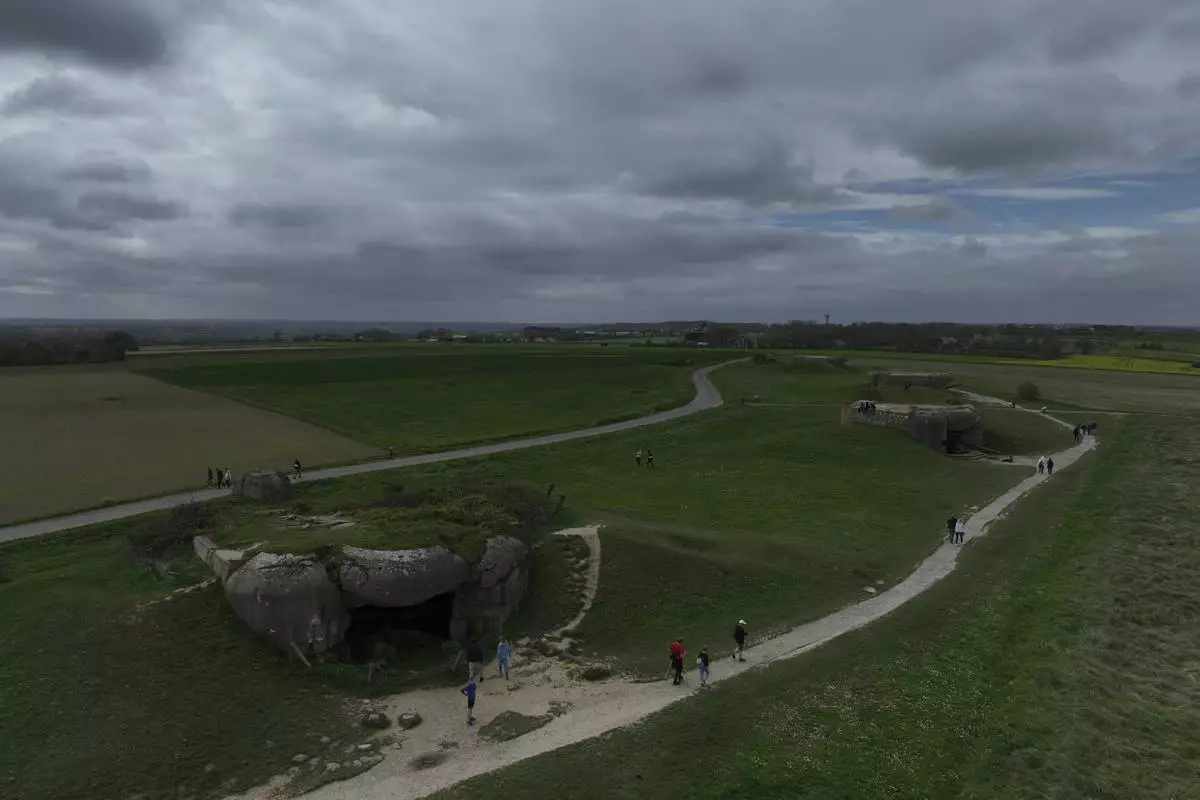
People walk by a bunker in Longues-sur-Mer, Normandy, Thursday, April 11, 2024. On D-Day, Charles Shay was a 19-year-old Native American army medic who was ready to give his life — and actually saved many. Now 99, he's spreading a message of peace with tireless dedication as he's about to take part in the 80th celebrations of the landings in Normandy that led to the liberation of France and Europe from Nazi Germany occupation. (AP Photo/Thibault Camus)
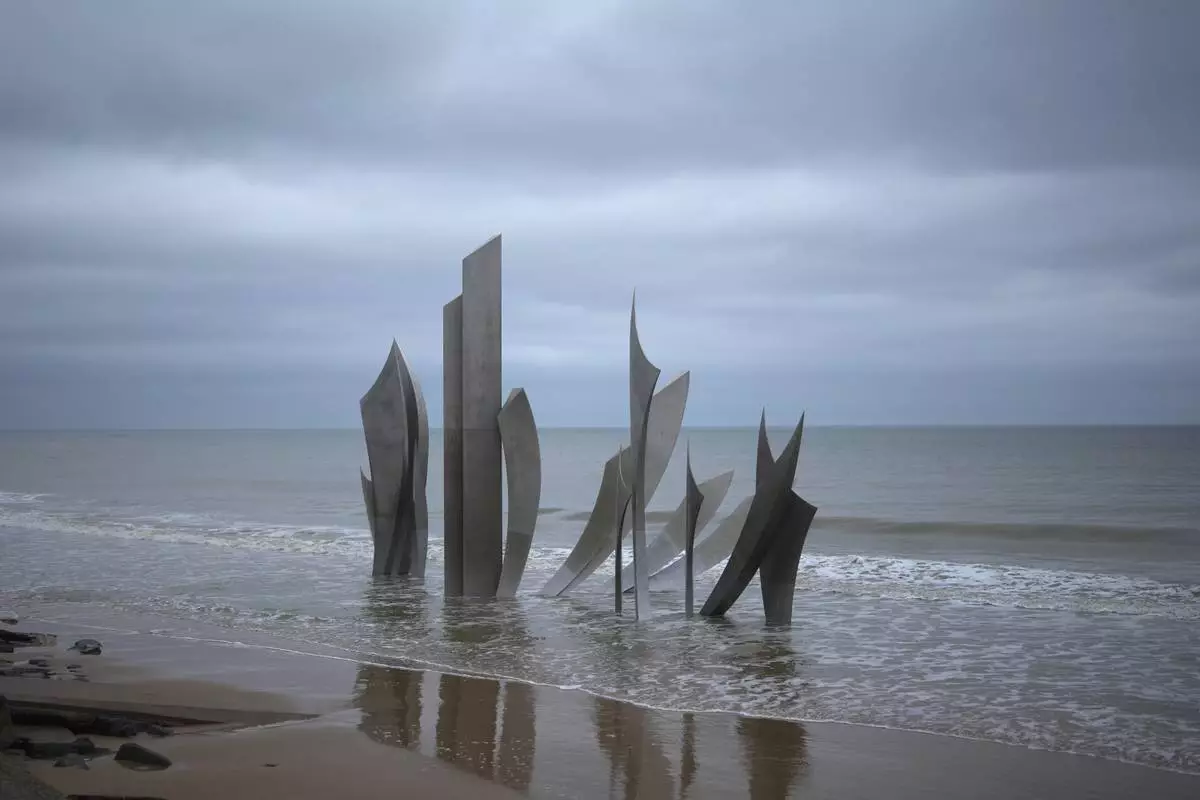
The monument called Les Braves, dedicated to the American soldiers who landed on Omaha Beach on D-Day, is seen on Omaha Beach at sunset, in Saint-Laurent-sur-Mer, Normandy, Thursday, April 11, 2024. On D-Day, Charles Shay was a 19-year-old Native American army medic who was ready to give his life — and actually saved many. Now 99, he's spreading a message of peace with tireless dedication as he's about to take part in the 80th celebrations of the landings in Normandy that led to the liberation of France and Europe from Nazi Germany occupation. (AP Photo/Thibault Camus)
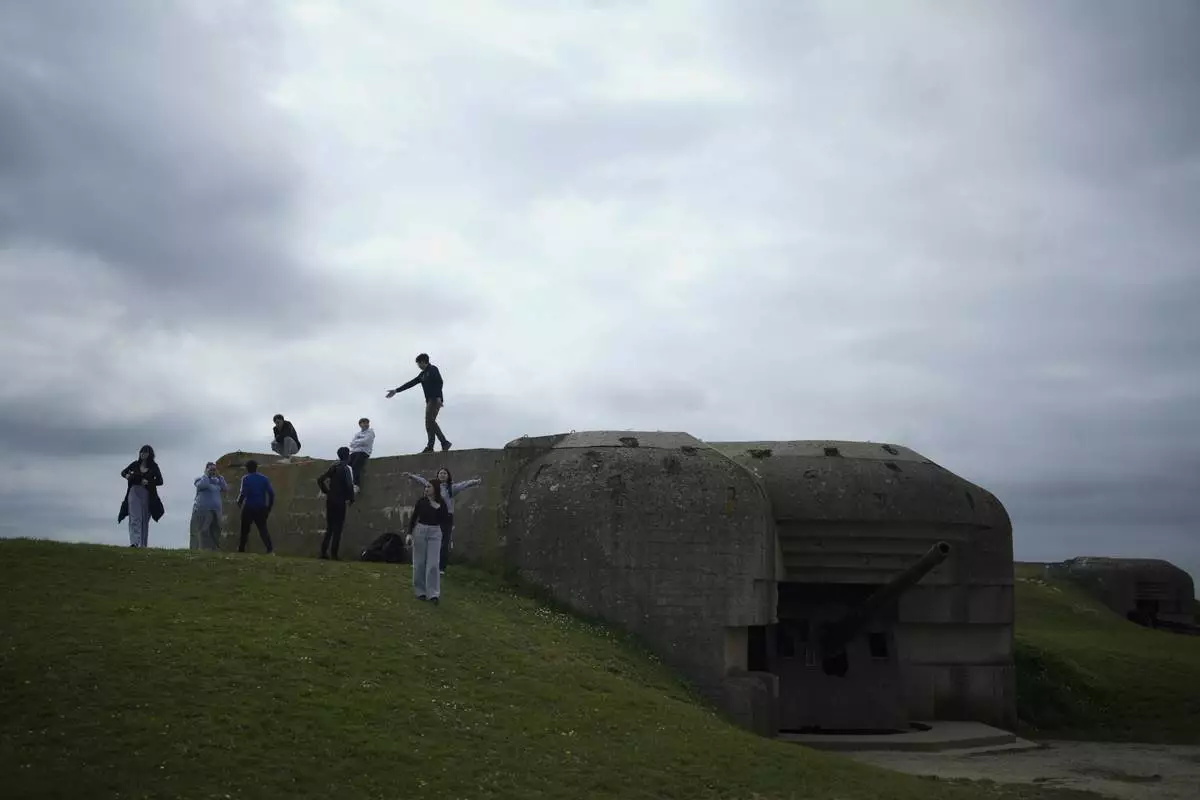
Students walk by a bunker in Longues-sur-Mer, Normandy, Thursday, April 11, 2024. On D-Day, Charles Shay was a 19-year-old Native American army medic who was ready to give his life — and actually saved many. Now 99, he's spreading a message of peace with tireless dedication as he's about to take part in the 80th celebrations of the landings in Normandy that led to the liberation of France and Europe from Nazi Germany occupation. (AP Photo/Thibault Camus)
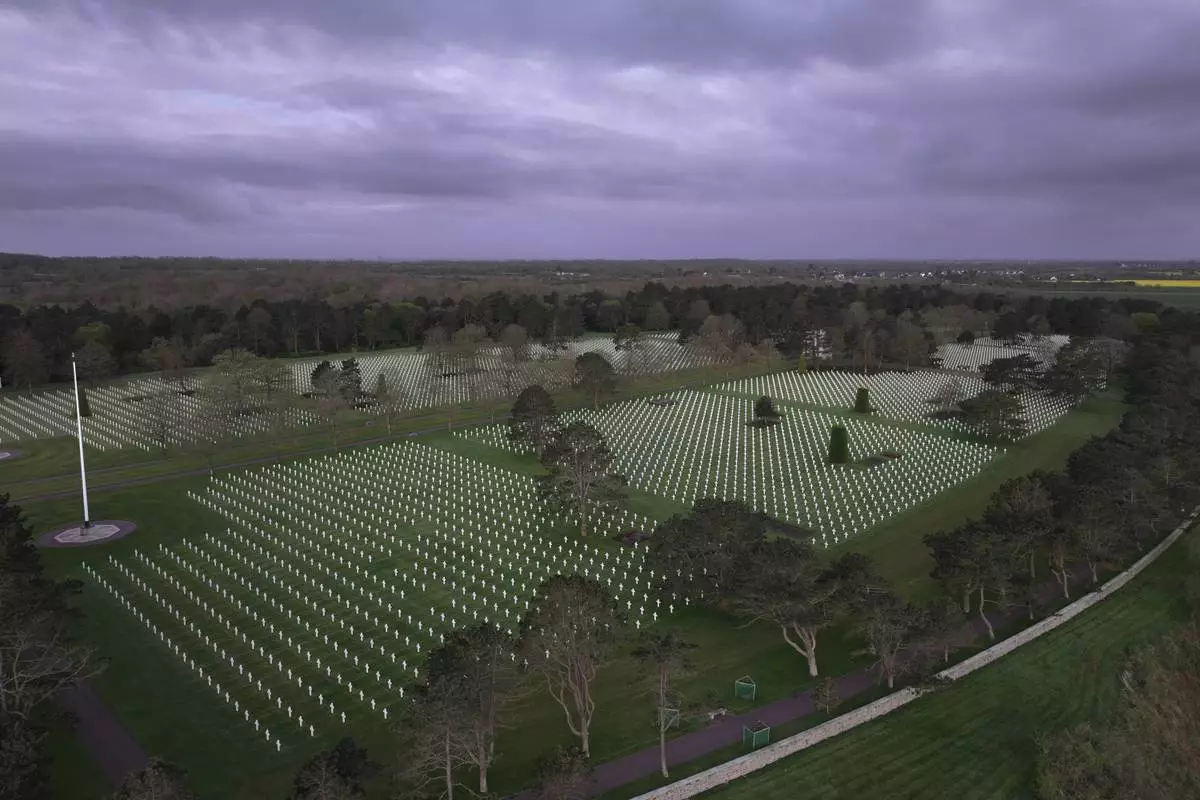
This photo taken on Wednesday April 10, 2024, shows crosses of the US cemetery of Colleville-sur-Mer, Normandy. On D-Day, Charles Shay was a 19-year-old Native American army medic who was ready to give his life — and actually saved many. Now 99, he's spreading a message of peace with tireless dedication as he's about to take part in the 80th celebrations of the landings in Normandy that led to the liberation of France and Europe from Nazi Germany occupation. (AP Photo/Thibault Camus)

The sun rises on the US cemetery of Colleville-sur-Mer, Normandy, Wednesday, April 10, 2024. On D-Day, Charles Shay was a 19-year-old Native American army medic who was ready to give his life — and actually saved many. Now 99, he's spreading a message of peace with tireless dedication as he's about to take part in the 80th celebrations of the landings in Normandy that led to the liberation of France and Europe from Nazi Germany occupation. (AP Photo/Thibault Camus)
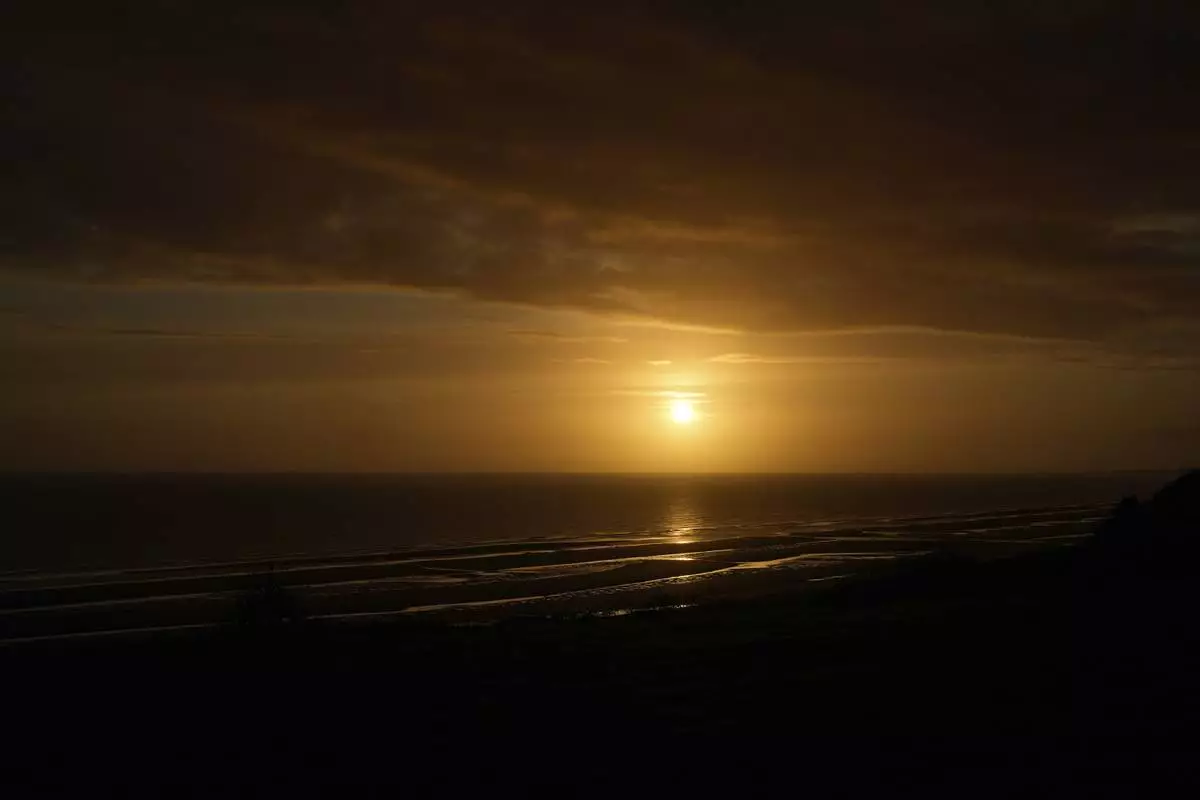
The sun rises on Omaha Beach in Colleville-sur-Mer, Normandy, Wednesday, April 10, 2024. On D-Day, Charles Shay was a 19-year-old Native American army medic who was ready to give his life — and actually saved many. Now 99, he's spreading a message of peace with tireless dedication as he's about to take part in the 80th celebrations of the landings in Normandy that led to the liberation of France and Europe from Nazi Germany occupation. (AP Photo/Thibault Camus)
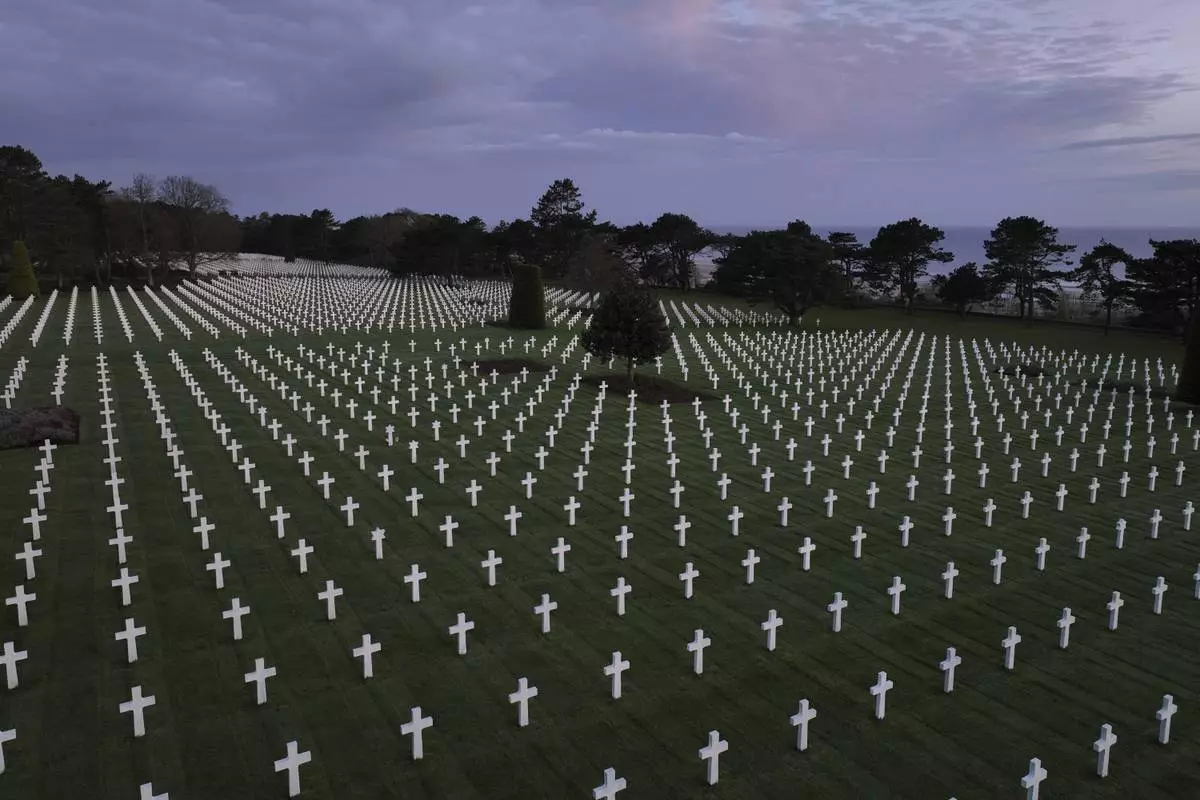
This photo taken on Wednesday April 10, 2024, shows crosses of the US cemetery of Colleville-sur-Mer, Normandy. On D-Day, Charles Shay was a 19-year-old Native American army medic who was ready to give his life — and actually saved many. Now 99, he's spreading a message of peace with tireless dedication as he's about to take part in the 80th celebrations of the landings in Normandy that led to the liberation of France and Europe from Nazi Germany occupation. (AP Photo/Thibault Camus)

This photo taken on Wednesday April 10, 2024, shows crosses of the US cemetery of Colleville-sur-Mer, Normandy. On D-Day, Charles Shay was a 19-year-old Native American army medic who was ready to give his life — and actually saved many. Now 99, he's spreading a message of peace with tireless dedication as he's about to take part in the 80th celebrations of the landings in Normandy that led to the liberation of France and Europe from Nazi Germany occupation. (AP Photo/Thibault Camus)
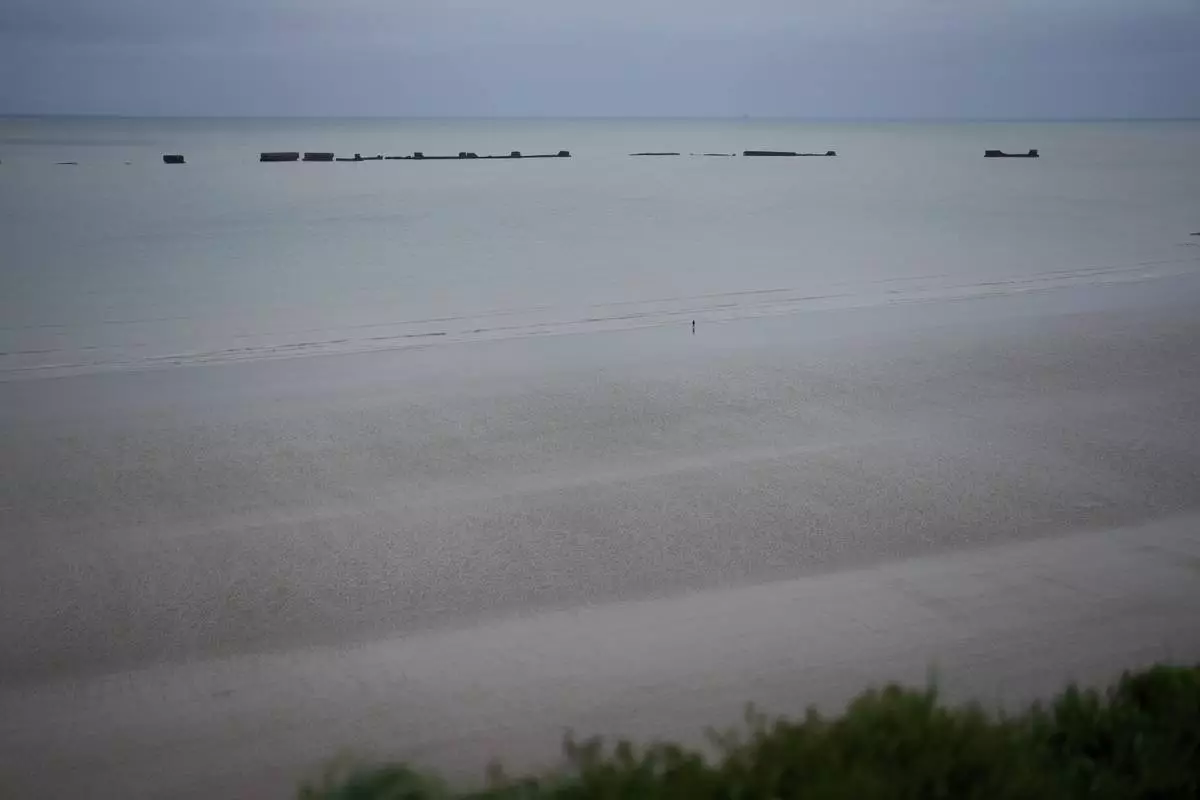
A man walks on Gold beach in Arromanches, Normandy, Wednesday, April 10, 2024. In the background are the remains of the artificial harbor of Arromanches. On D-Day, Charles Shay was a 19-year-old Native American army medic who was ready to give his life — and actually saved many. Now 99, he's spreading a message of peace with tireless dedication as he's about to take part in the 80th celebrations of the landings in Normandy that led to the liberation of France and Europe from Nazi Germany occupation. (AP Photo/Thibault Camus)
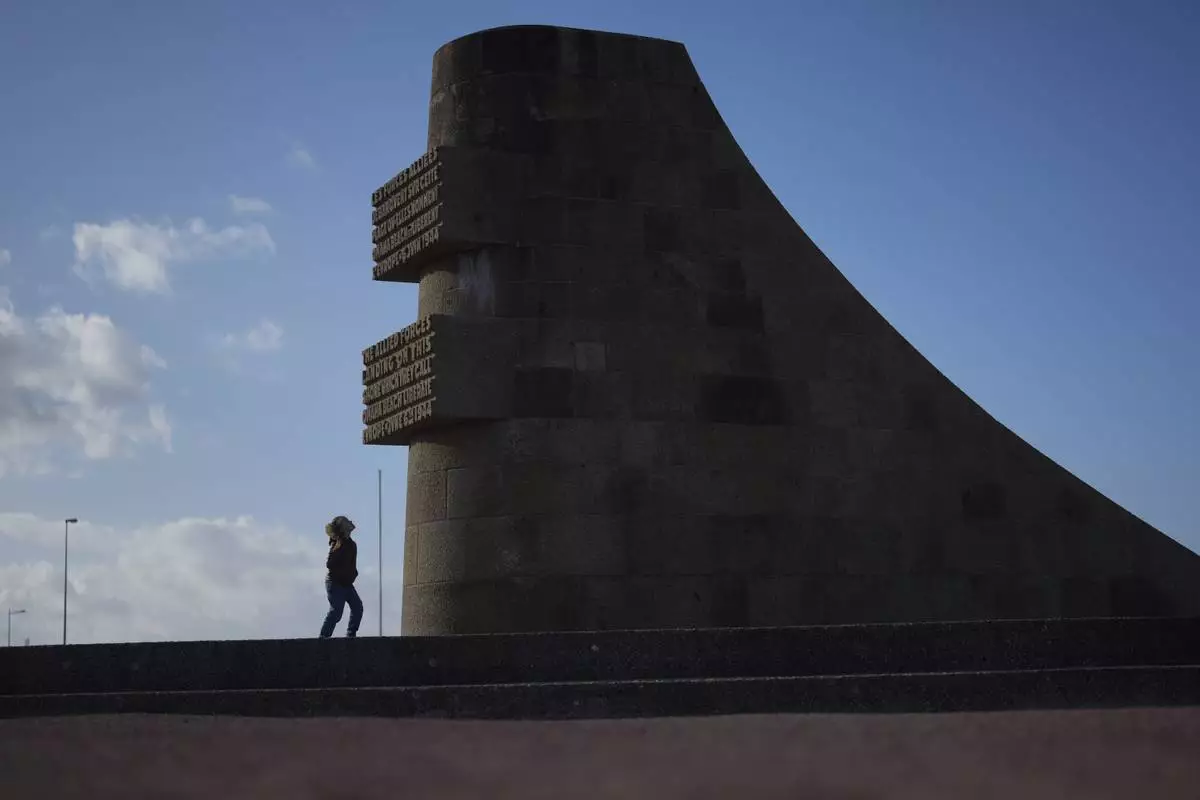
A girl watches the monument called Signal, dedicated to the American soldiers who landed on Omaha Beach on D-Day, on Omaha Beach at sunset, in Saint-Laurent-sur-Mer, Normandy, Tuesday, April 9, 2024. On D-Day, Charles Shay was a 19-year-old Native American army medic who was ready to give his life — and actually saved many. Now 99, he's spreading a message of peace with tireless dedication as he's about to take part in the 80th celebrations of the landings in Normandy that led to the liberation of France and Europe from Nazi Germany occupation. (AP Photo/Thibault Camus)
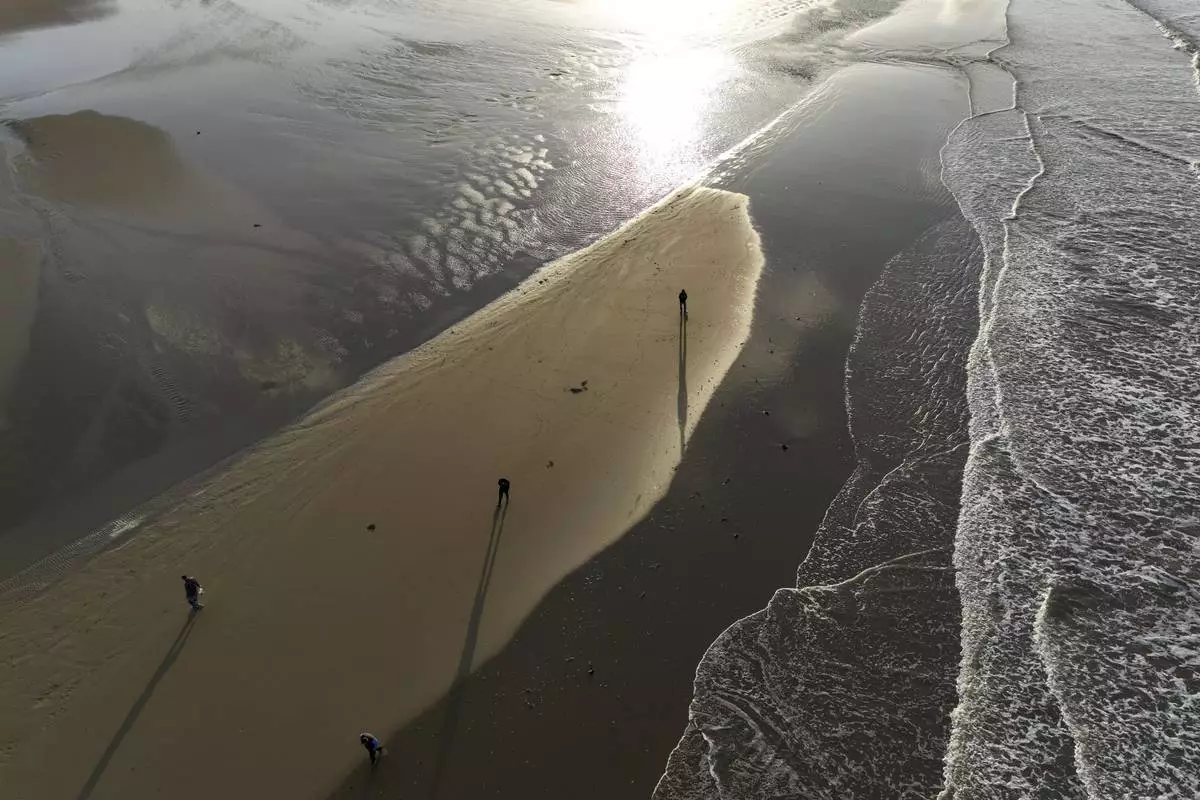
People walk on Omaha beach at sunset, in Saint-Laurent-sur-Mer, Normandy, Tuesday, April 9, 2024. On D-Day, Charles Shay was a 19-year-old Native American army medic who was ready to give his life — and actually saved many. Now 99, he's spreading a message of peace with tireless dedication as he's about to take part in the 80th celebrations of the landings in Normandy that led to the liberation of France and Europe from Nazi Germany occupation. (AP Photo/Thibault Camus)

Men of the American assault troops of the 16th Infantry Regiment, injured while storming a coastal area code-named Omaha Beach during the Allied invasion of the Normandy, wait by the chalk cliffs at Collville-sur-Mer for evacuation to a field hospital for further treatment, June 6, 1944. On D-Day, Charles Shay was a 19-year-old Native American army medic who was ready to give his life — and actually saved many. Now 99, he's spreading a message of peace with tireless dedication as he's about to take part in the 80th celebrations of the landings in Normandy that led to the liberation of France and Europe from Nazi Germany occupation. (AP Photo, File)

U.S. Army medical personnel administer a plasma transfusion to a wounded comrade, who survived when his landing craft went down off the coast of Normandy, France, in the early days of the Allied landing operations in June 1944. On D-Day, Charles Shay was a 19-year-old Native American army medic who was ready to give his life — and actually saved many. Now 99, he's spreading a message of peace with tireless dedication as he's about to take part in the 80th celebrations of the landings in Normandy that led to the liberation of France and Europe from Nazi Germany occupation. (AP Photo, File)
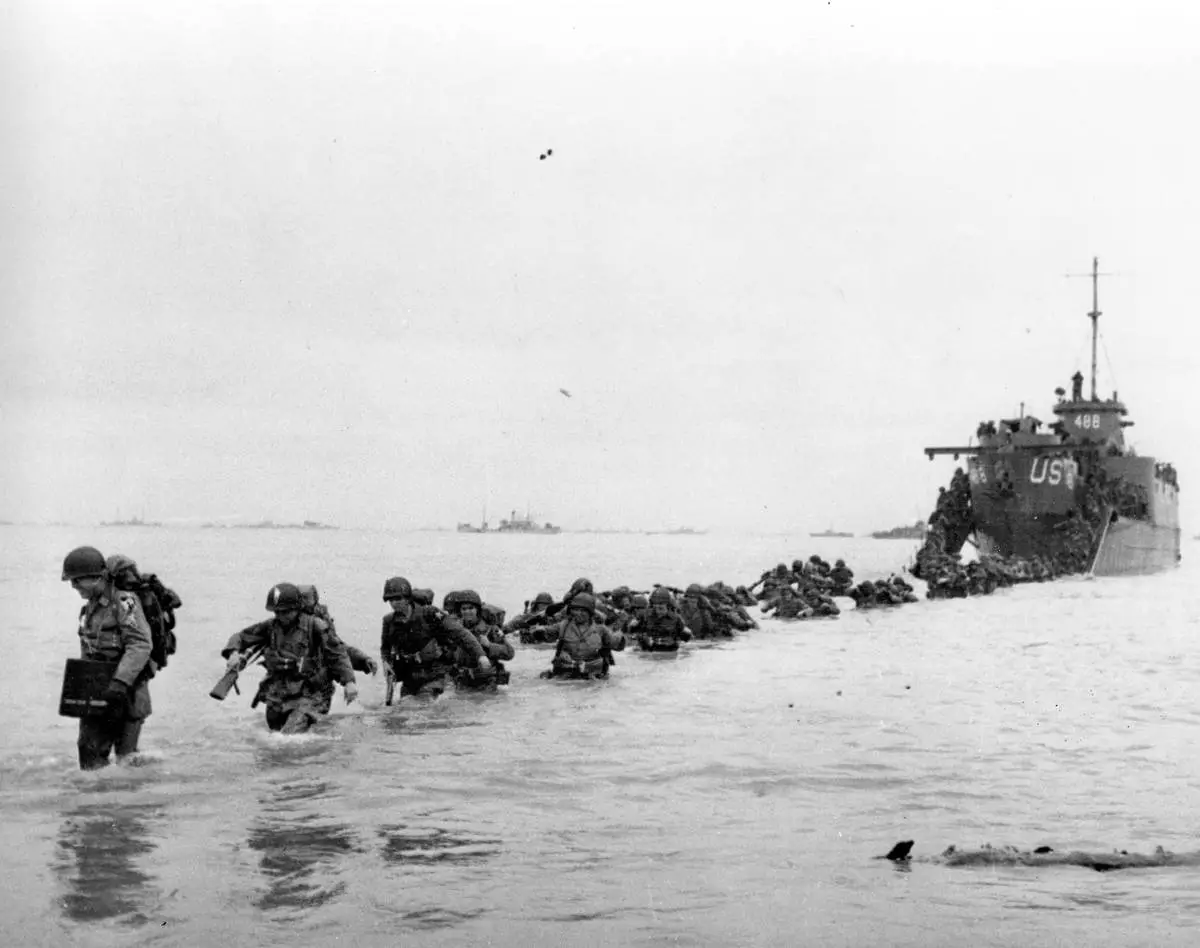
FILE - U.S. reinforcements wade through the surf from a landing craft in the days following D-Day and the Allied invasion of Nazi-occupied France at Normandy in June 1944 during World War II. On D-Day, Charles Shay was a 19-year-old Native American army medic who was ready to give his life — and actually saved many. Now 99, he's spreading a message of peace with tireless dedication as he's about to take part in the 80th celebrations of the landings in Normandy that led to the liberation of France and Europe from Nazi Germany occupation. (Bert Brandt/Pool via AP, File)
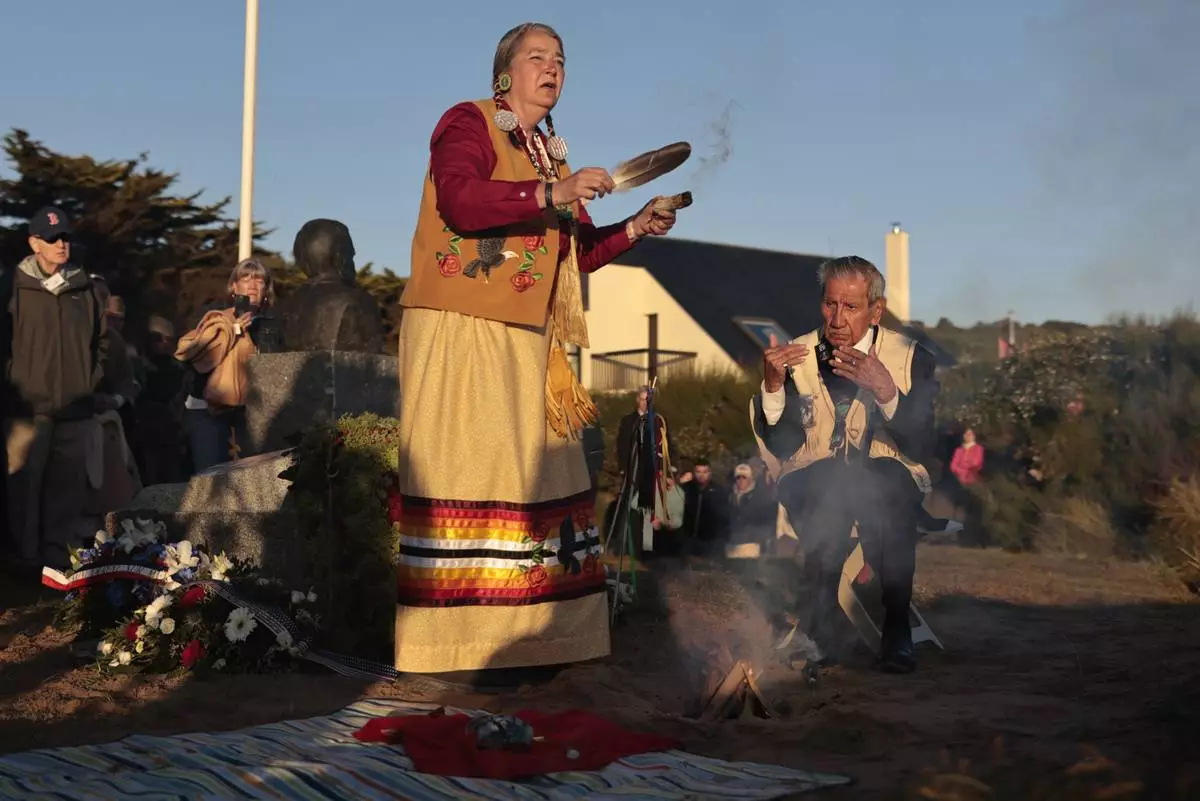
FILE - WWII veteran Charles Shay, 97, right, and Gulf war veteran Julia Kelly pay tribute to soldiers during a D-Day commemoration ceremony of the 78th anniversary for those who helped end World War II, in Saint-Laurent-sur-Mer, Normandy, France, Monday, June 6, 2022. On D-Day, Charles Shay was a 19-year-old Native American army medic who was ready to give his life — and actually saved many. Now 99, he's spreading a message of peace with tireless dedication as he's about to take part in the 80th celebrations of the landings in Normandy that led to the liberation of France and Europe from Nazi Germany occupation.(AP Photo/ Jeremias Gonzalez, File)
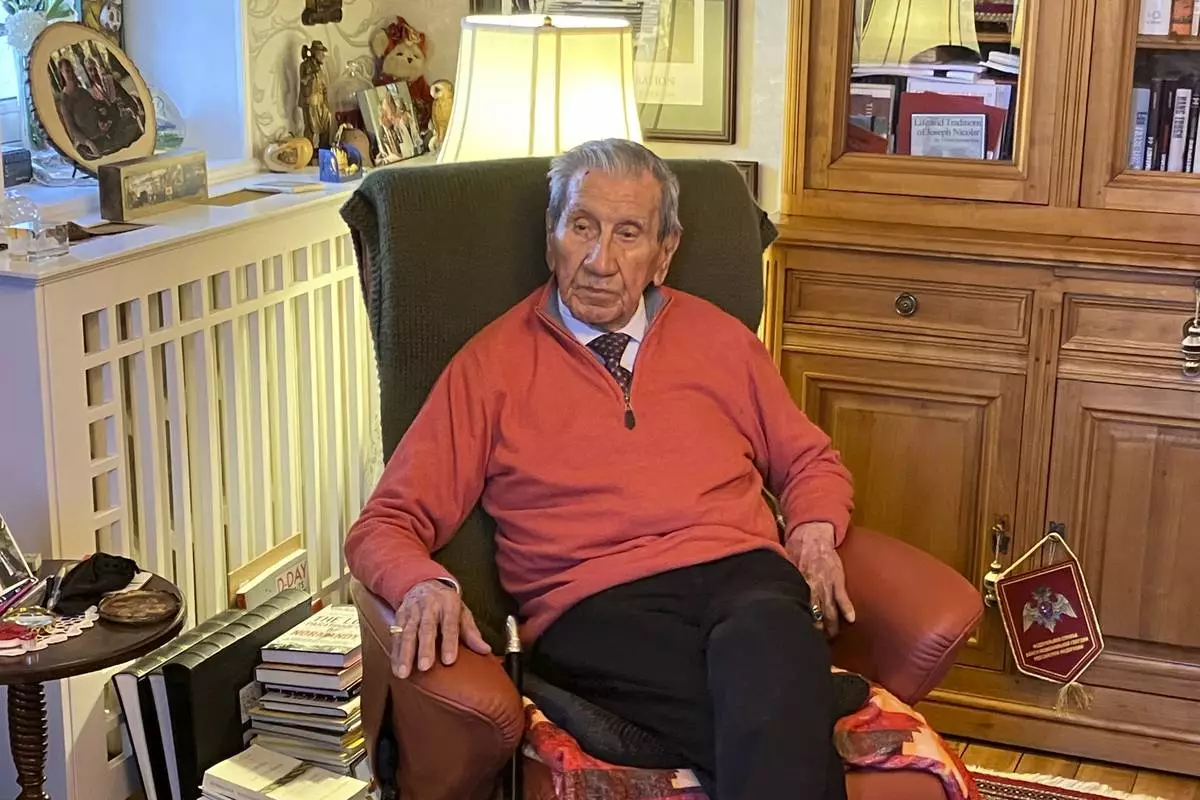
WWII veteran Charles Shay, is pictured at his home Sunday, March 24, 2024 in Bretteville-l'Orgueilleuse, Normandy. On D-Day, Charles Shay was a 19-year-old Native American army medic who was ready to give his life — and actually saved many. Now 99, he's spreading a message of peace with tireless dedication as he's about to take part in the 80th celebrations of the landings in Normandy that led to the liberation of France and Europe from Nazi Germany occupation. (AP Photo/Jeffrey Schaeffer)

FILE — WWII veteran Charles Shay, pays tribute to soldiers during a D-Day commemoration ceremony of the 78th anniversary for those who helped end World War II, in Saint-Laurent-sur-Mer, Normandy, France, Monday, June 6, 2022. On D-Day, Charles Shay was a 19-year-old Native American army medic who was ready to give his life — and actually saved many. Now 99, he's spreading a message of peace with tireless dedication as he's about to take part in the 80th celebrations of the landings in Normandy that led to the liberation of France and Europe from Nazi Germany occupation. (AP Photo/ Jeremias Gonzalez, File)
JACUMÉ, México (AP) — Near the towering border wall flanked by a U.S. Border Patrol vehicle, botanist Sula Vanderplank heard a quail in the scrub yelp “chi-ca-go,” a sound the birds use to signal they are separated from a mate or group.
Then silence.
A quail on the Mexican side called back, triggering a back-and-forth soundtrack that was both fitting and heartbreaking in an ecosystem split by an artificial barrier.
Vanderplank was among several botanists and citizen scientists participating in the Border Bioblitz near the Mexican community of Jacumé, about 60 miles (100 kilometers) east of Tijuana.
Roughly 1,000 volunteers armed with the iNaturalist app on their smartphones are documenting as many species as possible along the U.S.-Mexico border in May. Uploading photos to the app helps identify plants and animals, and records the coordinates of the location.
The hope is the information could lead to more protections for the region's natural richness, which is overshadowed by news of drug trafficking and migrant smuggling.
On a recent day, Bioblitz volunteers scrutinized a bright yellow blooming carpet of common Goldfields, a sharp contrast to the imposing steel bollards of the border wall topped with rolls of razor wire. Some navigated their way around piles of empty water jugs, a gray hoodie and empty cans of tuna fish left under the branches of native flora like the Tecate Cypress.
“There’s a fabulous amount of biodiversity here that’s traditionally been overlooked,” Vanderplank, of the binational program Baja Rare, said.
The efforts started in response to former President Donald Trump adding hundreds of miles of border walls that toppled untold numbers of saguaro cactuses in Arizona and passed through the biodiversity hotspot of Baja California.
“When the border wall construction began, we realized how little hard data we had, especially when it came to plants and small organisms,” Vanderplank said. “We don’t know what all we could lose.”
Since then, there has been a groundswell of initiatives to document the borderland’s flora and fauna as climate change coupled with habitat loss, pollution and development have hammered the world’s biodiversity. One estimate in 2019 warns that a million plant and animal species face extinction within decades, a rate of loss 1,000 times greater than expected.
The United Nations is expected hold a high-level meeting in Colombia of signatories to the Convention on Biological Diversity in October aiming to protect 30% of land, freshwater and oceans considered important for biodiversity by 2030, known as 30 by 30. Representatives from nearly 200 countries are expected to present plans on how they will meet conservation targets agreed upon in 2022.
Currently, 17% of terrestrial and 10% of marine areas are protected.
Baja California peninsula, which borders California and is home to Tijuana with one of Mexico's highest homicide rates, has more than 4,000 species of plants. A quarter of them are endemic and at least 400 plants are considered rare with little to no protection.
Flora and fauna that have gone extinct or are in danger of disappearing in the U.S., like the California red-legged frog, are thriving south of the border, producing specimens that are being used to bring back populations.
But the region’s crime deters many U.S. scientists from crossing the border. Mexico also is restricting permits for botanists and not allowing seeds to be collected, further curtailing the work, scientists say.
Bioblitz organizers work with local communities and say they take people only to areas deemed safe.
“You have to be really careful because of the violence,” said Jon Rebman, a curator of botany at the San Diego Natural History Museum, who has named 33 new plants for science from the southern California and Baja California region.
“It’s scary from that standpoint, yet those are the areas where we really need more information because there’s hardly any protected area on the south side,” he said.
Using the museum’s collection, Rebman made a list of 15 plant species endemic to Baja California and not seen since being collected nearly a century ago. He created a binational team to find them. So far, they have located 11.
Rebman also discovered two new plants to science in 2021 in a canyon off a Tijuana highway: the new species, Astragalus tijuanensis, and a new variety of the Astragalus brauntonii named lativexillum.
“I was worried they would go extinct before we even got them named,” Rebman said. “That tells you what type of area we’re working in.”
Tijuana-based botanist Mariana Fernandez of Expediciones Botánicas periodically checks on the plants. Working with Rebman, she is pushing Baja California to adopt more protections for its native plants. Currently only a fraction are on Mexico’s federal protection list.
She hopes the state will step in, while she also tries to build support by taking Tijuana residents and Baja officials on hikes.
“People are amazed that these things exist in Tijuana, and I hope to show more and more people so they can see the beauty, because we need that,” Fernandez said. “It’s important to not be impeded by the barriers that humans create.”
As border security increases with the number of people being displaced by natural disasters, violence and wars at record levels worldwide, more migrants are traipsing out to areas like the stretch near Jacumé. The tiny community of about 100 families includes members of the Kumeyaay tribe and sits across the border from an equally sparsely populated desert near the California town of Jacumba Hot Springs. Population: about 1,000.
The area has seen thousands of asylum seekers who wait for an opportunity to cross, usually in the cloak of darkness, and then camp again on the U.S. side after turning themselves in to U.S. Border Patrol agents.
Fernandez was among the botanists helping Bioblitz volunteers on the Mexican side near a crumbling crossing station from the 1920s.
“I never would have thought that there would be so much biodiversity on the border,” said Jocelyn Reyes, a student of Fernandez at La Universidad Autónoma de Baja California who stopped every few feet to hover over a plant and photograph its details. “It’s so interesting and makes you realize there’s so much worth saving.”

A California Horned Lizard is temporary held for classification during a botanical expedition with Universidad Autonoma de Baja California college students documenting native plants and species along the U.S.-Mexico border on Friday, April 19, 2024, in the Ejido Jacume in the Tecate Municipality of Baja California, Mexico. Botanists and citizen scientists armed with the iNaturalist app on their smartphones are recording the biodiversity along the U.S.-Mexico border in May. Called the Border Bioblitz, more than 1,000 volunteers are recording as many species as possible. (AP Photo/Damian Dovarganes)

Horses walk close to the US Mexico border Friday, April 19, 2024, in the Ejido Jacume in the Tecate Municipality of Baja California, Mexico. Botanists and citizen scientists armed with the iNaturalist app on their smartphones are recording the biodiversity along the U.S.-Mexico border in May. Called the Border Bioblitz, more than 1,000 volunteers are recording as many species as possible. (AP Photo/Damian Dovarganes)

Dr. Georges Seingier, Prof. Marine and Environmental Sciences at Baja California Autonomous University joins a botanical expedition with Universidad Autonoma de Baja California college students to document native plants along the U.S.- Mexico border on Friday, April 19, 2024, in the Ejido Jacume in the Tecate Municipality of Baja California, Mexico. The group near the Mexican community of Jacume, about (60 miles) 100 kilometers east of Tijuana, is one of several participating in the Border Bioblitz in which more than 1,000 volunteers throughout May record as many species as possible along the U.S.-Mexico border, a region plagued by drug trafficking and migrant smuggling that have overshadowed its natural richness. (AP Photo/Damian Dovarganes)

College students, members of Baja California's conservation organization Baja Rare, lead a botanical expedition to document native plants along the U.S.-Mexico border on Friday, April 19, 2024, in the Ejido Jacume in the Tecate municipality of Baja Calif., Mexico. The Baja California peninsula, which borders California and is home to Tijuana, one of the deadliest cities in the world, has more than 4,000 species of plants. According to scientists, a quarter of them are not found anywhere else, and some 200 plants are considered rare with little to no protection. (AP Photo/Damian Dovarganes)

A college student joins members of the California's Baja Rare conservation project leading a botanical expedition to document native plants along the U.S.- Mexico border on Friday, April 19, 2024, in the Ejido Jacume in the Tecate Municipality of Baja Calif., Mexico. Since then there has been a groundswell of initiatives to document the borderland's flora and fauna as climate change coupled with habitat loss, pollution and development have hammered the world's biodiversity, with one estimate in 2019 warning that a million plant and animal species face extinction within decades, a rate of loss 1,000 times greater than expected. (AP Photo/Damian Dovarganes)

Dr. Georges Seingier, Prof. Marine and Environmental Sciences at Baja California Autonomous University leads a botanical expedition with Universidad Autonoma de Baja California botanists and citizen scientists to document native plants along the U.S.- Mexico border on Friday, April 19, 2024, in the Ejido Jacume in the Tecate Municipality of Baja California, Mexico. Since then there has been a groundswell of initiatives to document the borderland's flora and fauna as climate change coupled with habitat loss, pollution and development have hammered the world's biodiversity, with one estimate in 2019 warning that a million plant and animal species face extinction within decades, a rate of loss 1,000 times greater than expected. (AP Photo/Damian Dovarganes)

Members of the Baja California's conservation Baja Rare project lead a botanical expedition with college students to document native plants along the U.S.-Mexico border on Friday, April 19, 2024, in the Ejido Jacume in the Tecate Municipality of Baja Calif., Mexico. The group near the Mexican community of Jacume, about (60 miles) 100 kilometers east of Tijuana, is one of several participating in the Border Bioblitz in which more than 1,000 volunteers throughout May record as many species as possible along the U.S.-Mexico border, a region plagued by drug trafficking and migrant smuggling that has overshadowed its natural richness. (AP Photo/Damian Dovarganes)

Lichen grows on native tree branches along the US-Mexico border on Friday, April 19, 2024, in the Ejido Jacume in the Tecate Municipality of Baja California, Mexico. Botanists and citizen scientists armed with the mobile cellphone iNaturalist app are recording the biodiversity along the U.S.-Mexico border in May. The Border Bioblitz has more than 1,000 volunteers recording as many species as possible. Flora and fauna that have gone extinct or are in danger of disappearing in the U.S. have been found to be thriving in remote spots south of the border, producing specimens that can then be used to bring back populations, scientists say. But the region's crime has deterred many U.S. scientists from crossing the border. (AP Photo/Damian Dovarganes)

Botanists and citizen scientists armed with the iNaturalist app on their smartphones record the biodiversity along the U.S.-Mexico border as bright yellow blooms carpet the ground, a sharp contrast to the imposing steel bollards of the border wall topped with rolls of razor wire as members of the California's Baja Rare project lead a botanical expedition with college students to document native plants along the US Mexico border on Friday, April 19, 2024, in the Ejido Jacume in the Tecate Municipality of Baja Calif., Mexico. (AP Photo/Damian Dovarganes)

Tijuana-based field botanist Mariana Fernandez of Expediciones Botanicas leads a botanical expedition with college students to document native plants along the U.S.- Mexico border on Friday, April 19, 2024, in the Ejido Jacume in the Tecate Municipality of Baja California, Mexico. Flora and fauna that have gone extinct or are in danger of disappearing in the U.S. have been found to be thriving in remote spots south of the border, producing specimens that can then be used to bring back populations, scientists say. But the region's crime has deterred many U.S. scientists from crossing the border. (AP Photo/Damian Dovarganes)

Botanists and citizen scientists armed with the iNaturalist app on their smartphones record the biodiversity along the U.S.-Mexico border as bright yellow blooms carpet the ground, a sharp contrast to the imposing steel bollards of the border wall topped with rolls of razor wire along the US Mexico border on Friday, April 19, 2024, near Botanists and citizen scientists armed with the iNaturalist app on their smartphones record the biodiversity along the U.S.-Mexico border as bright yellow blooms carpet the ground, a sharp contrast to the imposing steel bollards of the border wall topped with rolls of razor wire as members of the California's Baja Rare project lead a botanical expedition with college students to document native plants along the US Mexico border on Friday, April 19, 2024, near the Ejido Jacume in the Tecate Municipality of Baja Calif., Mexico. (AP Photo/Damian Dovarganes)

Bright yellow blooms carpet the ground, a sharp contrast to the imposing steel bollards of the border wall topped with rolls of razor wire as members of the California's Baja Rare conservation project lead a botanical expedition with botanists and citizen scientists to document native plants along the U.S.- Mexico border on Friday, April 19, 2024, in the Ejido Jacume in the Tecate Municipality of Baja Calif., Mexico. (AP Photo/Damian Dovarganes)



















